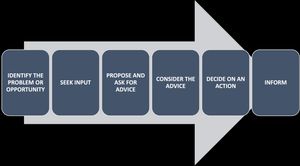The Power of Collaborative Decision-Making: Implementing the Advice Process in Teal Organizations
Do you find yourself frustrated with traditional decision-making processes? Are you tired of the top-down approach that stifles creativity and innovation? Then perhaps it's time to consider the advice process, a key element in the Teal organization model that empowers individuals and promotes collective wisdom.

In Teal organizations, the Advice Process is a fundamental part of decision-making. It allows anyone to make any decision after seeking advice from everyone who will be affected and people with expertise in the matter. The decision-maker considers all relevant advice but ultimately chooses the best action. Power is now distributed, and everyone's input is valued. Decisions are distributed and can be taken close to where the information exists and with speed.
The Advice Process, invented by Dennis Bakke at AES and described in his book "Joy at Work," differs from consensus-based decision-making, where everyone has veto power. In the Advice Process, used still at AES, power and responsibility rest with the decision-maker, typically the person most affected by the issue. The decision-maker considers all the advice but ultimately makes the decision.
Benefits
Implementing the advice process can have several benefits.
For one, it creates a sense of community by involving people advising on the decisions in the process.
It also encourages humility, as seeking advice is an act of modesty, and recognizes the importance of collaboration.
In addition, the advice process promotes learning, as advice comes from those with expertise and a stake in the outcome.
Advice-seeking drives transparency since all information needed for the decision is brought into clear light.
It also leads to better decisions, providing diverse perspectives and highlighting important issues.
Finally, it can be a fun and stimulating process that promotes creativity and innovation.
The process

Step 1: Identify the problem or opportunity
The first step in the Advice Process is identifying a problem or opportunity that needs a decision. Anything from a minor operational issue to a significant strategic decision is possible in this process. It's essential to be clear on the problem, opportunity, and desired outcomes.
Step 2: Seek input
Before proposing, the decision-maker may seek input from everyone affected by the decision and people with expertise in the matter.
Step 3: Propose and ask for advice
The decision-maker should make a well thought proposal based on the input received, considering all the relevant information and perspectives. The proposal should be clear and concise and outline the decision's rationale. Seek advice from everyone affected by the decision and people with expertise in the matter, including but not limited to colleagues, customers, suppliers, and other stakeholders. It's crucial to ensure that everyone's input is heard and valued.
Step 4: Consider the advice
The decision-maker should consider all the advice received, considering the relevant information and perspectives. It's essential to be open to different viewpoints and willing to change the proposal if necessary.
Step 5: Decide on an action
The decision-maker should decide on the best course of action based on the advice received. This decision should be well-reasoned and take into account all the relevant factors. It's important to communicate the decision to those who have given advice.
Step 6: Inform
The decision-maker should inform those advising of the proposal, about the final decision and its rationale. Then make the decision available to all in the organization. This openness helps build trust and transparency and ensures everyone is aware of the decision.
Tips for applying the advice process
Be clear on the problem or opportunity and the outcomes you want to achieve.
Seek input from everyone affected and people with expertise. Start by defining the scope of the decision. Next, identify who will be affected by the decision and who has relevant expertise, helping you identify from who to seek input.
Decision-makers should be proactive in seeking input from diverse sources. Seek opinions and feedback from people with different backgrounds, perspectives, and experiences. Consider using surveys or focus groups to gather input from a larger group.
Decision-makers should actively seek and encourage people to share their opinions, even if they go against the prevailing view. By doing so, potential blind spots surface, ensuring consideration of all perspectives.
Consider using anonymous feedback to ensure people feel comfortable sharing their honest opinions. Anonymity can help to prevent people from self-censoring or feeling pressure to conform to the prevailing view.
Make a well-thought-out proposal that considers all the relevant information and perspectives.
Consider all the advice received, and be open to different viewpoints.
Decide on the best course of action based on the advice received.
Communicate the decision and rationale to those who have given advice.
Implementing the Advice Process requires a certain mindset and training. The process is most effective when approached with a co-creative mindset that values collaboration and creativity. Additionally, organizational leaders need to model the behavior they want to see in others. By recognizing that the person most affected by a decision is often the best person to make it, seeking advice from those with expertise, and ultimately taking responsibility for the decision.
Tools for the advice process
In any distributed process, it is vital to have transparency and openness around the information. Therefore, it is essential to use a tool that everyone affected by a particular decision can access both before and after the decision.
Examples of simple tools to use:
The decision-maker can post a proposal on the company wiki or teams chat group or send an email to all, call for comments, invite email responses, and then process the advice they receive.
The organization can use the backlog tool they are already using, like Azure DevOps or Jira. For example, a decision can be an item in a unique backlog in that tool.
The organization can use decision-making software like Loomio, an open-source tool with a small monthly fee if used online. The process for using the advice process on Loomio: start a discussion to frame the topic and gather input, host a proposal so everyone affected by the issue can voice their position, and then the final decision-maker specifies the outcome (automatically notifying the whole group).
Conclusion
In conclusion, the Advice Process is a powerful tool that can transform organizations' decisions; empowering individuals and promoting collaboration leads to better decisions, stronger communities, and a more fulfilling workplace. So why not give it a try and see what kind of results you can achieve?
References and further reading
Bakke, D. W. (2005). Joy at Work: A Revolutionary Approach To Fun on the Job.
Laloux, F. (2014). Reinventing Organizations. Retrieved 2 2, 2022
Last updated May 27, 2025
